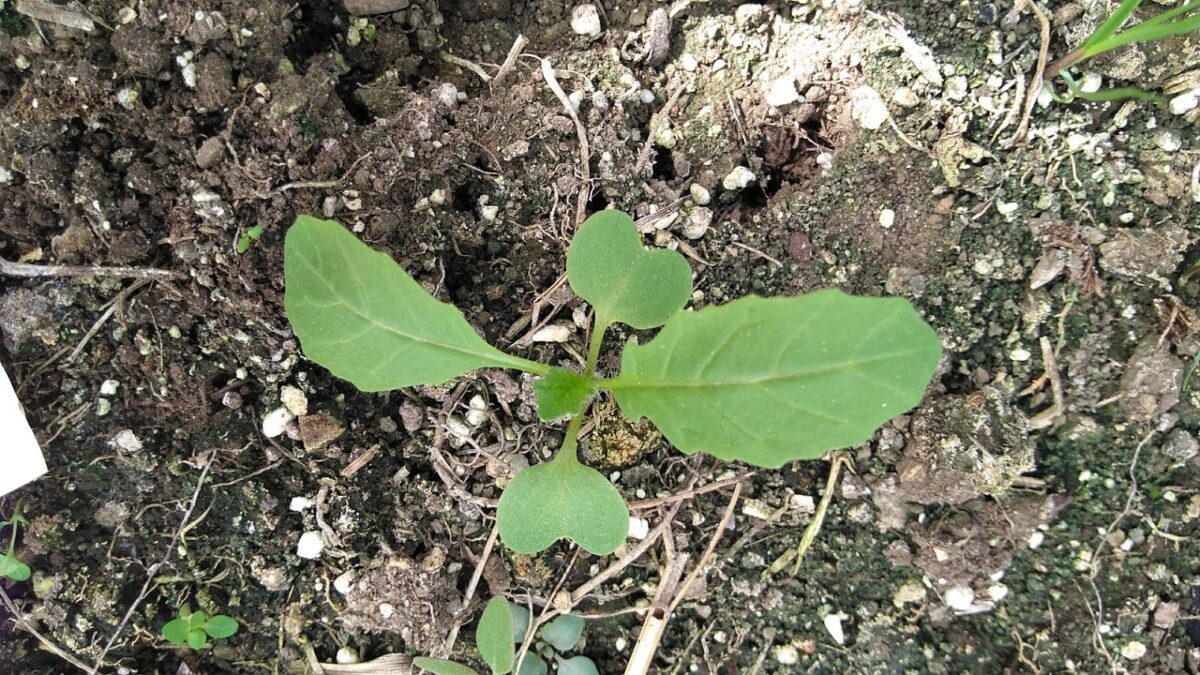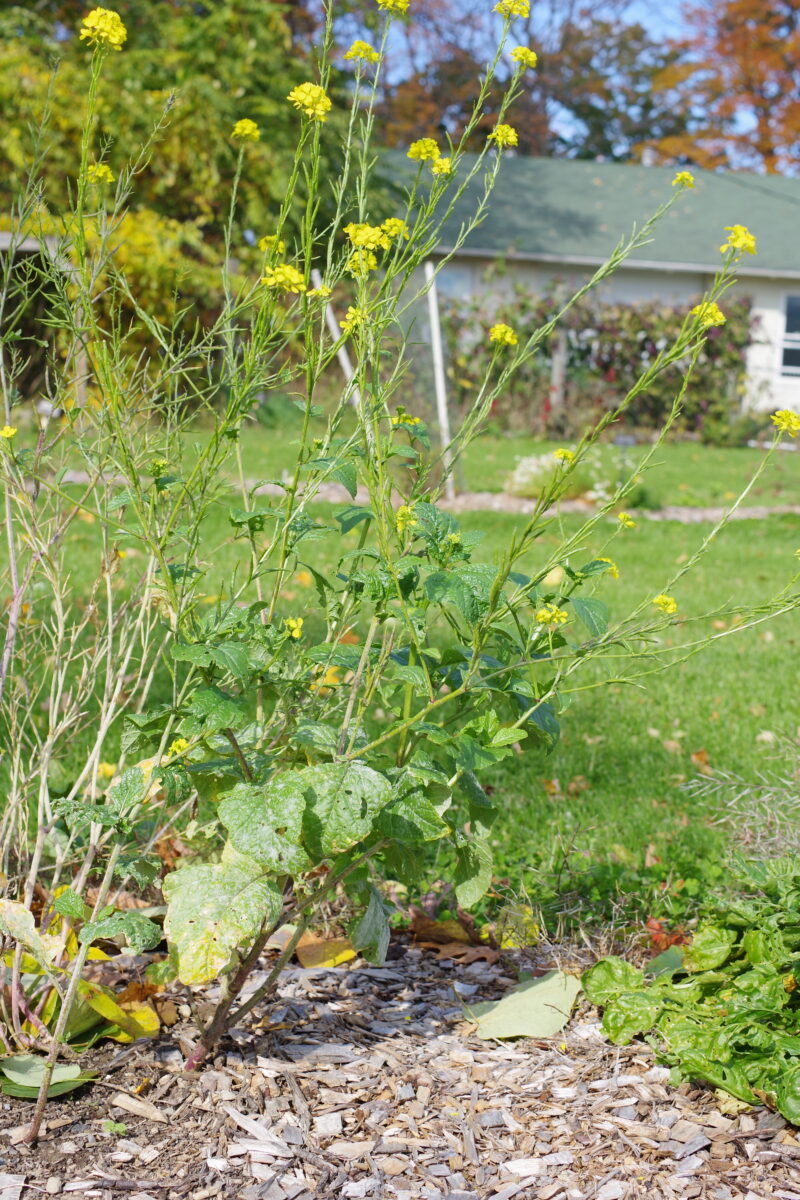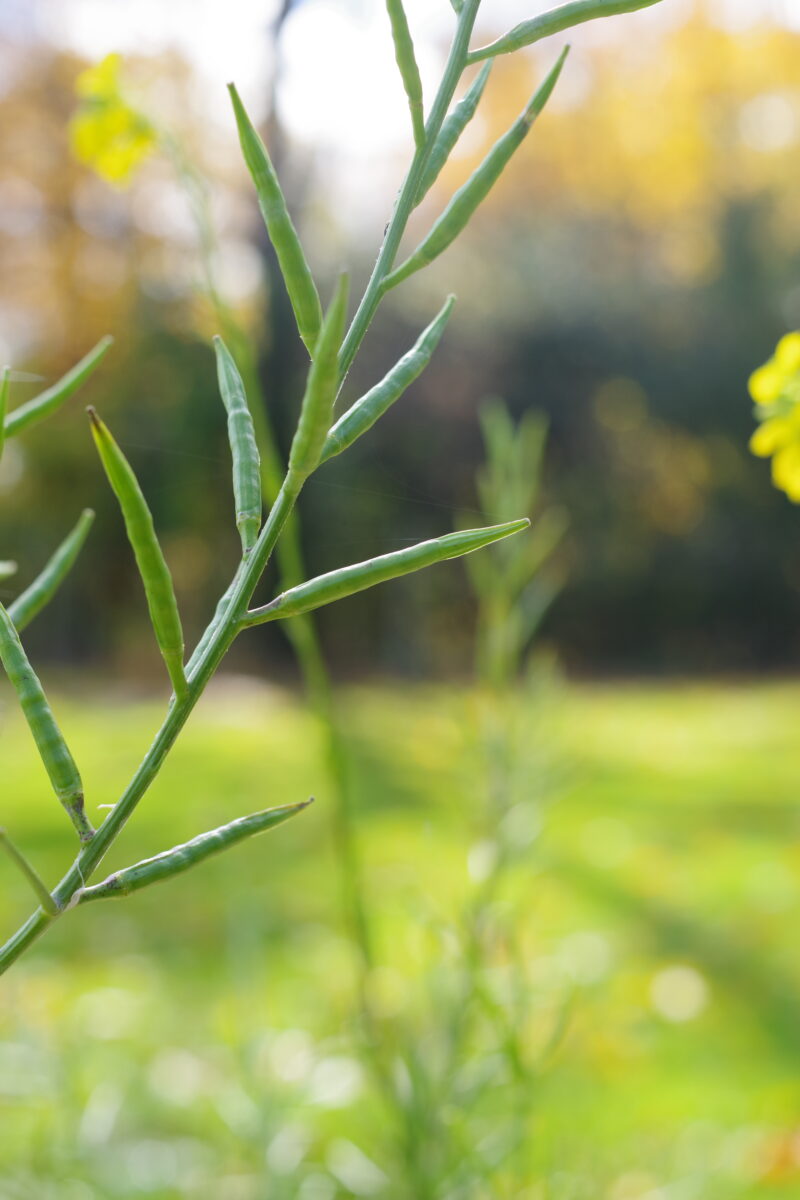Other common names: charlock, field mustard, field kale, kedlock, common mustard, crunchweed, kraut weed, water cress, yellow flower, herrick, yellow mustard



Sinapis arvensis L. = Brassica kaber (DC.) L.C. Wheeler
Identification of Wild Mustard
Family: Mustard family, Brassicaceae
Habit: Highly branched, summer annual herb
Description: Seedlings have cotyledons that are kidney or heart shaped to round, with the indentation at the tip, and are 0.25–0.5 inch long by 0.25–0.75 inch wide. The cotyledons are hairless and have 0.4 inch-long stalks. Young seedling leaves are alternate, egg to club shaped and 0.4–0.8 inch long. Leaf edges are wavy with wide, irregular teeth. The upper surface of the leaves has scattered stiff hairs, a somewhat wrinkled appearance and conspicuous sunken veins. Leaf stalks are 0.1–0.25 inch long and hairy. Early leaves form a basal rosette. Mature plants have hairy stems and are 16–40 inches tall. The stem hairs are stiff, sparse, point towards the base and are denser lower on the stem. Leaves are alternate, hairy, 2–10 inches long by 0.5–2.75 inches wide, and larger towards the base of the plant. Lower leaves have long stalks, are oval to egg shaped, deeply lobed and broadest at the tip. Upper leaves are smaller, lanceolate and have short stalks or are stalkless. The root system is a thin and branched taproot with many fibrous secondary roots. Clusters of yellow, four-petaled flowers develop at branch tips on 0.1–0.3 inch-long stalks. The flowers are 0.5–1.25 inch wide. Flowers and seedpods are often present simultaneously. Seedpods are upright, cylindrical, 1–1.75 inch long by 0.08–0.12 inch wide, with 0.2–0.3 inch-long stalks and a tapering, two- or four-sided, flat tipped beak. The seeds are reddish brown or dark brown to black, round and 0.06 inch wide.
Similar species: White mustard (Sinapis alba L.) has stalked upper leaves and hairy seedpods, while the upper leaves of wild mustard are often without stalks and the seedpods are hairless. Wild radish (Raphanus raphanistrum L.) has hairier, rougher leaves than those of wild mustard. Wild radish flowers have dark-veined petals, while the flowers of wild mustard lack distinct veins. Wild radish seedpods are larger than those of wild mustard; they appear “beaded” instead of entire or smooth, and they break into segments rather than splitting open when ripe.
Management of Wild Mustard
This species establishes very quickly, and consequently it is among the hardest weeds to control with cultivation. If you expect wild mustard to be a problem based on past years, plant large seeded crops a little deeper than usual and blind cultivate aggressively before crop emergence. This practice will be most effective if the crop is planted near its optimum season for establishment. Frequent early cultivations will pay off, especially if your equipment will allow you to get close to the crop row. Throw soil into the crop row as soon as the crop will tolerate it to bury wild mustard seedlings.
Wild mustard reaches its peak emergence following tillage in early to mid-spring, particularly when tillage is preceded by fertilization with inorganic nitrogen. If an area is particularly thick with this species, consider rotating to a late planted crop, and use a spring tilled fallow period to flush out and destroy part of the seed bank.
The growth rate and competitive ability of wild mustard increases greatly with increasing nitrogen fertility, so if this weed is a problem, avoid over fertilizing with nitrogen rich inputs. Wild mustard grows best and is more competitive when nitrogen is side-dressed earlier rather than later, so apply nitrogen as late as possible after the crop is established. This species is sensitive to shading, so plant highly competitive crops in fields where this weed is abundant. High density plantings of cereal grains also are effective for suppressing the weed since it usually is shorter than the grain.
In cereal grains, most pods generally remain closed and seeds are retained on the plant until harvest. Consequently, weed seed collection during combining could substantially reduce population density.
Ecology of Wild Mustard
Origin and distribution: Wild mustard is native to temperate regions of Europe, Asia and North Africa. It has been introduced into North and South America, Australia and South Africa. It occurs throughout the agricultural regions of North America.
Seed weight: Seed mass ranges from 1–2.3 mg. Light brown colored seeds averaged 1.2 mg, whereas dark brown colored seeds averaged 1.5 mg.
Dormancy and germination: Some seeds can germinate immediately following seed shed (21% in one experiment), but most freshly shed seeds are dormant with typically about 5% germination. Smaller plants with fewer fruit produced black seeds that had higher dormancy than red seeds produced on larger plants with more fruit. The higher mass and dormancy of dark compared to light colored seeds may be accounted for by the thicker seed coat of dark seeds. Exposure to freezing temperatures over winter can relieve some dormancy, increasing germination from 5% to 28%. When buried deeply in soil, dormancy is induced in seeds, but burial over winter can increase germination and emergence if seeds are brought to the surface the following spring. The degree of light sensitivity apparently varies between populations and environmental conditions, but generally germination is only weakly stimulated by exposure to light alone. Germination is stimulated by a combination of exposure to light and inorganic nitrogen. Under these conditions, optimum temperatures for germination are 50–68°F, with daily alternating temperatures giving maximum response. In favorable conditions, seed germination occurs in two to four days, and emergence in the field occurs five to seven days after initiation of germination.
Seed longevity: When left undisturbed, a few seeds can remain viable in the soil for 60 years, especially if they are deeply buried. However, mortality of seeds buried in packets in the surface 1 inch of soil was 22–45% per year. Similarly, mortality of wild mustard seeds in tilled agricultural soils was 20–52% annually.
Season of emergence: Wild mustard emerges primarily during the spring, beginning when soil temperature exceeds 40°F and recent rainfall has occurred. It continues to emerge sporadically throughout the growing season with a secondary peak of emergence in the fall.
Emergence depth: Emergence is best from at or near the soil surface, is moderate from 2 inches and is negligible from 4 inches or deeper.
Photosynthetic pathway: C3
Sensitivity to frost: Wild mustard can survive temperatures down to 22°F but suffers some damage. Late germinating plants are commonly winter-killed before they can set seed.
Drought tolerance: Wild mustard has an exceptionally high density of stomates on the leaves, which would facilitate rapid growth with optimum soil moisture but could make it relatively drought sensitive under low soil moisture conditions. However, wild mustard establishes an extensive root system. For example, a study found that the total length of all roots added together was 3 feet by the fifth day and 394 feet by 21 days after emergence. In one experiment, drought stress reduced plant height by 90% and seed production by 97%, but in another experiment, wild mustard plant height, seed production, seed dormancy and competitive ability were only moderately decreased by drought.
Mycorrhiza: Wild mustard does not form symbiotic relationships with mycorrhizal fungi.
Response to fertility: Wild mustard is highly responsive to N fertility, with plant size increasing in response to application rates of 480 pounds per acre. Increasing nitrogen fertility can enhance the competitiveness of wild mustard relative to selected crops, but barley can outcompete wild mustard even at high N application rates. Delaying N side-dressing from 28 to 56 days after emergence reduced wild mustard biomass and seed production by approximately 50%. The species was highly responsive to P in one experiment but was relatively unresponsive in two other experiments. Plants grew twice as large on soil with a K test of 147 pounds per acre relative to soil with a test of 52 pounds per acre. Wild mustard plants have a high sulfur content and may respond to S. Growth is reduced substantially at a pH of 4.7–4.8 compared to a pH of 5.7–6.5.
Soil physical requirements: Wild mustard grows on a variety of soil types but grows best and is most competitive on clay soils. Emergence is impaired in soils that dry and become crusted.
Response to shade: Shade reduces growth rate and seed production of wild mustard, while time to flowering lengthens.
Sensitivity to disturbance: Because of the rapidly developing root system of wild mustard, plants very quickly become resistant to rotary hoeing or tine weeding, and so these operations should target the weed in the white thread stage. Small plants are susceptible to manual hoeing or cultivation, but plants nearing the flowering stage are prone to rerooting in moist weather.
Time from emergence to reproduction: Wild mustard is a long-day plant that flowers and produces seed when day length exceeds 16 hours. In the northern parts of its range, wild mustard flowers three to six weeks after emergence, with late emerging plants flowering most quickly. Seeds mature five to six weeks later. Time to flowering can be highly variable depending on drought and crop competition, both of which can delay flowering. In warmer parts of the United States fall emerging plants overwinter, flower in the spring and set seeds in early summer.
Pollination: Unlike most annual weeds, wild mustard is self-incompatible. Although it is an introduced species, plants are cross pollinated by a wide variety of native insects. It provides nectar and pollen that attract beneficial insects that prey on crop pests.
Reproduction: Plants in agricultural fields produce from 10–18 seeds per pod and 2,000–3,500 seeds per plant when competing with crops under normal moisture conditions. Plants growing without competition are larger and produce more seeds. Reproduction is substantially reduced when plant density is low and plants are isolated from pollinator habitats. Wild mustard can die as the seeds form or may continue to produce mature pods until frost depending on conditions, but seeds are generally not released until the plant is dead. In Saskatchewan, more than 98% of wild mustard seeds were retained at harvest of field peas and spring wheat, suggesting that this species would be suitable for control by novel harvest practices that collect and destroy weed seeds.
Dispersal: Since the pods are slow to open, wild mustard pods growing in grain fields are often collected and the seeds dispersed by combines and also as contaminants in grain and forage seed. Seeds are also dispersed in manure and in soil clinging to shoes, tires and tillage machinery.
Common natural enemies: Wild mustard frequently shows substantial leaf damage from imported cabbageworm (Pieris rapae) and flea beetles (Phyllotreta spp.). Despite substantial foliar and root damage from cabbageworms and wireworms, respectively, damaged plants can compensate and still produce similar numbers and mass of seeds as plants that have not been attacked.
Palatability: The young plants are palatable to livestock and are marginally palatable to humans when cooked. The seeds contain toxins, and animals should not be allowed to eat more than small amounts of maturing plants.
Summary Table of Wild Mustard Characteristics
| Wild Mustard | ||||||||
|---|---|---|---|---|---|---|---|---|
| Growth habit | Seed weight (mg) | Seed dormancy at shedding | Factors breaking dormancy | Optimum temperature for germination (F) | Seed mortality in untilled soil (%/year) | Seed mortality in tilled soil (%/year) | Typical emergence season | Optimum emergence depth (inches) |
| medium, branched | 1–2.3 | Yes | cms, li, at, ni | 50–68 | 22–45 | 20–52 | spring | 0–0.8 |
| Photosynthesis type | Frost tolerance | Drought tolerance | Mycorrhiza | Response to nutrients | Emergence to flowering (weeks) | Flowering to viable seed (weeks) | Pollination | Typical & high seed production (seeds per plant) |
| C3 | high | low | no | high | 3–6 | 5–6 | cross | 3,000 & na |
Table Key
General: The designation “–” signifies that data is not available or the category is not applicable.
Growth habit: A two-word description; the first word indicates relative height (tall, medium, short, prostrate) and second word indicates degree of branching (erect, branching, vining).
Seed weight: Range of reported values in units of “mg per seed.”
Seed dormancy at shedding: “Yes” if most seeds are dormant when shed, “Variable” if dormancy is highly variable, “No” if most seeds are not dormant.
Factors breaking dormancy: The principle factors that are reported to break dormancy and facilitate germination. The order of listing does not imply order of importance. Abbreviations are:
scd = seed coat deterioration
cms = a period subjected to cold, moist soil conditions
wst = warm soil temperatures
li = light
at = alternating day-night temperatures
ni = nitrates
Optimum temperature range for germination: Temperature (Fahrenheit) range that provides for optimum germination of non-dormant seeds. Germination at lower percentages can occur outside of this range. The dash refers to temperature range, and the slash refers to alternating day/night temperature amplitudes.
Seed mortality in untilled soil: Range of mortality estimates (percentage of seed mortality in one year) for buried seeds in untilled soil. Values were chosen where possible for seeds placed at depths below the emergence depth for the species and left undisturbed until assessment. Mortality primarily represents seed deterioration in soil.
Seed mortality in tilled soil: Range of mortality estimates (percentage of seed mortality in one year) for seeds in tilled soil. Values were chosen for seeds placed within the tillage depth and subjected to at least annual tillage events. Seed losses are the result of dormancy-breaking cues induced by tillage, germination and deterioration of un-germinated seeds.
Typical emergence season: Time of year when most emergence occurs in the typical regions of occurrence for each weed. Some emergence may occur outside of this range.
Optimum emergence depth: Soil depths (in inches below the soil surface) from which most seedlings emerge. Lower rates of emergence usually will occur at depths just above or just below this range.
Photosynthesis type: Codes “C3” or “C4” refer to the metabolic pathway for fixing carbon dioxide during photosynthesis. Generally, C3 plants function better in cooler seasons or environments and C4 plants function better in warmer seasons or environments.
Frost tolerance: Relative tolerance of plants to freezing temperatures (high, moderate, low).
Drought tolerance: Relative tolerance of plants to drought (high, moderate, low).
Mycorrhiza: Presence of mycorrhizal fungi. “Yes” if present; “no” if documented not to be present, “unclear” if there are reports of both presence and absence; “variable” if the weed can function either with or without, depending on the soil environment.
Response to nutrients: Relative plant growth response to the nutrient content of soil, primarily N, P, K (high, moderate, low).
Emergence to flowering: Length of time (weeks) after emergence for plants to begin flowering given typical emergence in the region of occurrence. For species emerging in fall, “emergence to flowering” means time from resumption of growth in spring to first flowering.
Flowering to viable seed: Length of time (weeks) after flowering for seeds to become viable.
Pollination: “Self” refers to species that exclusively self-pollinate, “cross” refers to species that exclusively cross-pollinate, “self, can cross” refer to species that primarily self-pollinate, but also cross-pollinate at a low rate, and “both” refers to species that both self-pollinate and cross-pollinate at relatively similar rates.
Typical and high seed production potential: The first value is seed production (seeds per plant) under typical conditions with crop and weed competition. The second value, high seed production, refers to conditions of low density without crop competition. Numbers are rounded off to a magnitude that is representative of often highly variable reported values.
Further Reading
Edwards, M. 1980. Aspects of the population ecology of charlock. Journal of Applied Ecology 17: 151–171.
Mulligan, G.A. and L.G. Bailey. 1975. The biology of Canadian weeds. 8. Sinapis arvensis L. Canadian Journal of Plant Science 55: 171–183.
Paolini, R., M. Principi, R.J. Froud-Williams, S. Del Puglia and E. Biancardi. 1999. Competition between sugarbeet and Sinapis arvensis and Chenopodium album, as affected by timing of nitrogen fertilization. Weed Research 39: 425–440.
Warwick, S.I., H.J. Beckie, A.G. Thomas and T. McDonald. 2000. The biology of Canadian weeds. 8. Sinapis arvensis L. (updated). Canadian Journal of Plant Science 80: 939–961.

